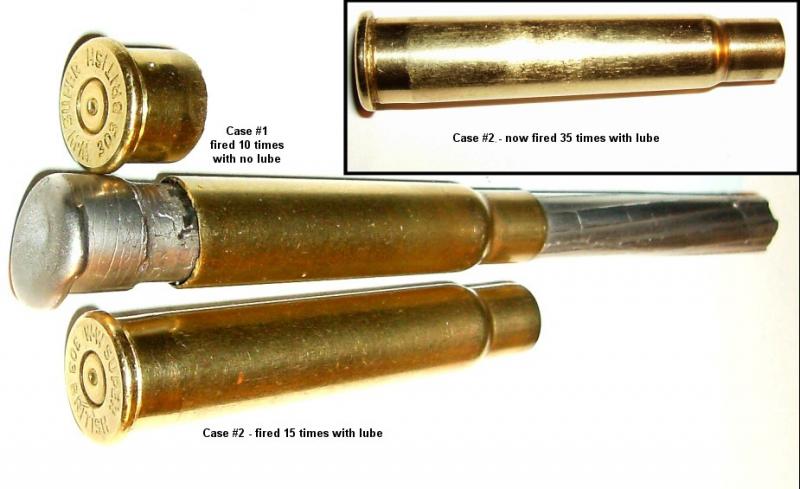Well, I finally got a chance to put another 20 shots through the .303 case that refused to fail if I kept it lightly lubed. With 35 lubed firings now, it still insists on keeping its head.
Initially, this was a test to compare dry and lubed Winchester .303 cases fired in a good LithgowSMLE to see if there would be any difference in case longevity - or any damage to the rifle. Having an excess of cheap Remington .311" 180-RN bullets and a near-full jug of RL-15, I picked two old W-W cases that showed no signs of wear or stretch - probably because I usually shoot fairly gentle cast-bullet loads in my Lee-Enfields. I trimmed the two cases to 2.210", annealed the necks, then loaded and fired them with the Remington 180's, 41 grains of RL-15, and Remington 9½ primers. I used a Lee collet die for neck-sizing so there'd be no chance of disturbing the shoulders.
After 5 shots dry, case #1 had grown to 2.222" and I trimmed it back to 2.210". By the 7th shot, the first indication of incipient separation appeared in the usual location about 1/8" ahead of the solid web - after the 9th shot it was really obvious. On the 10th shot the case separated and was stuck so tight I couldn't budge it with a standard "broken shell extractor". I finally got it out by pouring a Cerrosafe chamber cast and driving both cast and case with a flat-ended steel rod from the muzzle.
I then fired case #2 with the same load but put a light coat of castor oil on it before each firing. After 15 shots it still measured 2.210" and showed no signs of stretch or thinning. I checked the rifle for any change in headspace, damage, or wear and found nothing I could feel, see, or measure.
Today I set up the chronograph and kept loading and firing the same case, again putting a thin coat of castor oil on it before each firing. Since there had been no adverse results at 41 grains, 1 grain below maximum per Alliant, I went to 42 grains, which Alliant calls maximum (and lists at 2479 fps with the Speer 180 RN bullet in a 24" barrel). To my surprise, five of these averaged just 2261 fps. The next five, at 43 grains, went 2328. 44 grains averaged 2383 fps. Finally, at 45 grains, the final five shots averaged 2450 fps, what I'd call "service velocity" for a .303. (All I can figure is that this lot of RL-15 is a bit on the slow side. Even at 3 grains over "max" there were no signs of abnormal pressure.)
Please note that this was a torture test, not load development and definitely no kind of recommendation!
That was enough for me. I'd fired a total of 35 shots with this one case. It is still the same length as when I started, 2.210" and shows no signs of stretching or thinning. Except for more scratching and scuffing on the body, it seems not to have been changed at all. Frankly, I was surprised by this. Previous experience leaving sizing lube on cases had given me the impression that lube wasn't effective at preventing case stretch with full-power loads. Maybe putting a fresh coat on just before firing each shot made it work better.
My good old SMLE seems unaffected by this test as well. Headspace is unchanged and there's no added wear I can see or measure. I'm pleased by that since I've had this rifle since 1963 and it's definitely an old friend.
I'll be the first to agree that firing just 45 shots with two cases from one rifle doesn't prove a damn thing. Plenty of genuine authorities who know a lot more than me have said in no uncertain terms that any lubricant should be removed from cases and chambers before firing - because failure to do this might damage rifle or shooter.
I'm certainly not saying I know something all those guys don't. Rather, I'm just the kind of nut who has to try stuff anyhow and thought some of you might like to know how it turned out - this time. Maybe someone seeing this has or will run more/better tests and let us know the results. What I'd really like to see is somebody with one of those Oehler Model 43 outfits slap a strain-gauge on a Lee-Enfield side rail and try to quantify the lube effect on action flex. Now that would be interesting!Information

Warning: This is a relatively older thread
This discussion is older than 360 days. Some information contained in it may no longer be current.
- Knowledge Library

- MKL Entry of the Month
- Australia
- Austro-Hungarian Empire
- Canada
- Czechoslovakia
- Denmark
- Finland
- France/Belgium
- Germany
- Italy
- Japan
- Norway
- Russia
- South America
- Sweden
- Switzerland
- Turkey
- United Kingdom
- United States
- Yugoslavia
- Is my rifle authentic or a fake?
- Jay Currah's Lee Enfield Web Site
- On-line Service Records (Canada)
- Technical Articles/Research
- Forum
- Classifieds

- What's New?
-
Photo Gallery

- Photo Gallery Options
- Photo Gallery Home
- Search Photo Gallery List
-
Photo Gallery Search
- Video Club

- iTrader












 PM
PM
